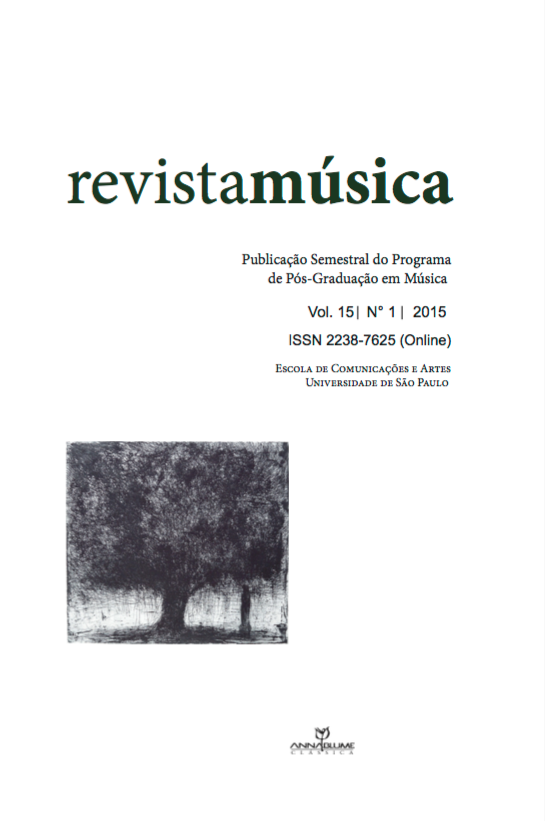To ‘Raise and Quell’: the Emotional Pulse
DOI:
https://doi.org/10.11606/rm.v15i1.114702Keywords:
Musical Rhetoric, Rhythm, Musical performanceAbstract
This article describes the importance of rhythm in controlling the emotional state of the listener. Rhythmic impulses originate in the human body, through movement and speech. The ancient writers and orators noted how different rhythms in speech could affect the feelings of an audience. When rhetoric began to influence musical composition in the 16th century, composers were quick to realize the potential for expressing emotion by using various rhythmic devices borrowed from speech patterns. The manner of performance also influences the way these devices are received by the listener.Downloads
References
ARISTOTLE. The Art of Rhetoric. Transl. by E. H. Freese. Cambridge: Heinemann (Loeb Classical Library), 1934.
CICERO. De Oratore. Transl. by E. W. Sutton. Cambridge: Heinemann (Loeb Classical Library), 1942.
HALICARNASSUS, Dionysius of. On Literary Composition. Transl. by W. Rhys Roberts. Cambridge: Heinemann (Loeb Classical Library), 1974.
HOULE, George. Meter in Music, 1600-1800. Michigan: Indiana University Press, 1987.
MATTHESON, Johann. Der vollkommene Capellmeister (Hamburg, 1739). Kassel: Bärenreiter, 1991.
MONTEVERDI, Claudio. Preface to Madrigali Guerrieri. Book VIII (1638). Milano: Ricordi, 1967.
NORTH, Roger. On Music. London: Novello, 1959.
QUANTZ, Johann Joachim. On Playing the Flute. Transl. by Edward Reilly. Boston: Northeastern University Press, 2001.
QUINTILIAN, Marcus Fabius. Institutio Oratoria. Transl. by H. E. Butler. Cambridge: Heinemann (Loeb Classical Library), 1998.
QUINTILIANUS, Aristides. On Music, in three books. Transl. by T. Mathiesen. New Haven: Yale University Press, 1983.
ROUSSEAU, Jean Jacques. Dictionnaire de Musique. Paris: Duchesne, 1768.
TARLING, Judy. The Weapons of Rhetoric. London: Corda Music Publications, 2008.
WEST, M.L. Ancient Greek Music. Oxford: Oxford University Press, 1992.
Downloads
Published
Issue
Section
License
Copyright (c) 2015 Judy Tarling

This work is licensed under a Creative Commons Attribution-NonCommercial-ShareAlike 4.0 International License.
Autores que publicam nesta revista concordam com os seguintes termos:
- Autores mantém os direitos autorais e concedem à revista o direito de primeira publicação, com o trabalho simultaneamente licenciado sob a CC Attribution-NonCommercial-ShareAlike 4.0 que permite o compartilhamento do trabalho com reconhecimento da autoria e publicação inicial nesta revista.
- Autores têm autorização para assumir contratos adicionais separadamente, para distribuição não-exclusiva da versão do trabalho publicada nesta revista (ex.: publicar em repositório institucional ou como capítulo de livro), com reconhecimento de autoria e publicação inicial nesta revista.
- Autores têm permissão e são estimulados a publicar e distribuir seu trabalho online (ex.: em repositórios institucionais ou na sua página pessoal) a qualquer ponto antes ou durante o processo editorial, já que isso pode gerar alterações produtivas, bem como aumentar o impacto e a citação do trabalho publicado (Veja O Efeito do Acesso Livre).


